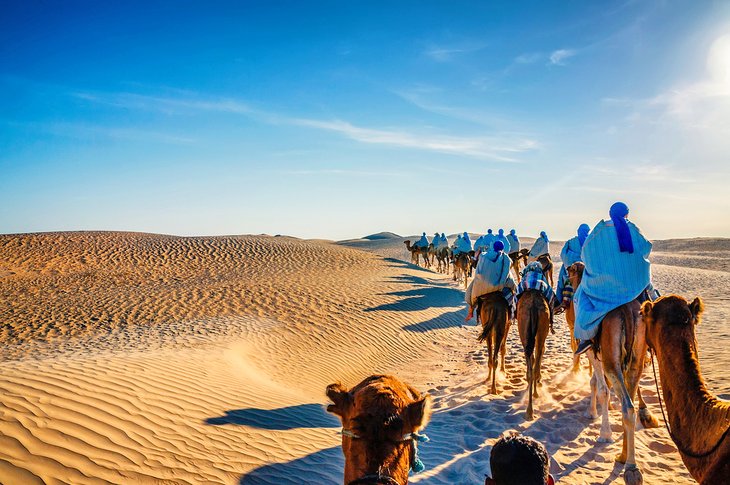
Tunisia offers a wealth of experiences for the intrepid traveler. Here's a comprehensive 10-day itinerary to help you discover the very best of Tunisia.Tunisia Tourism Board and Rough Guides provided valuable information and insights for this article.
Begin your journey in Tunis, the capital city that combines tradition and modernity seamlessly. Visit the Medina of Tunis, a UNESCO World Heritage Site, and wander around its narrow alleys lined with colorful houses and workshops.
Just a short trip from Tunis, visit the historic city of Carthage. Founded by the Phoenicians around 800 BC, the city was once a powerful commercial empire. Today, the ruins of Carthage include Phoenician and Roman remnants like the Antonine Baths, Punic Ports, and Carthage Acropolium.
After exploring Carthage, head to the nearby village of Sidi Bou Said. Perched on a steep cliff overlooking the Mediterranean Sea, the village is known for its blue-and-white architecture, narrow winding streets, and artistic atmosphere. Enjoy a cup of Tunisian mint tea in one of the many cafes and soak in the stunning views of the Gulf of Tunis.
Journey to the holy city of Kairouan, a UNESCO World Heritage Site and the fourth holiest city in the Islamic world. Visit the iconic Great Mosque of Kairouan, also known as the Mosque of Uqba, with its impressive minaret and stunning mihrab.
Next, visit the picturesque Aghlabid Basins, an engineering marvel built in the 9th century, which functioned as a water reservoir during times of siege. Continue on to El Jem to marvel at the massive Roman Colosseum – a UNESCO World Heritage Site and one of the best-preserved Roman amphitheaters in the world.
Arrive in the coastal city of Sousse, where you can explore the Medina, Ribat (a medieval fortified monastery), and the Museum of Archaeology. Afterward, relish delicious seafood and relax on one of the magnificent beaches that the city has to offer.
From Sousse, travel to Monastir, which is home to one of the oldest and most impressive fortresses in Tunisia, the Ribat of Monastir, as well as the Mausoleum of Habib Bourguiba, Tunisia's first president. Take time to unwind on its stunning beaches or try water sports such as jet-skiing and scuba diving.
Head to the gorgeous coastal town of Mahdia, characterized by whitewashed houses and picturesque squares. Visit the stunning Mahdia Marina, and don't miss the ancient city gate, Bab al-Bahr, which leads to the old town peninsula.
Explore the historic sites such as the Great Mosque (Jama' al-Kebir) and El Kebir Fortress. Afterward, relish the fresh seafood in a local restaurant while taking in the stunning sunset views over the Mediterranean Sea.
Travel to the desert oasis town of Douz, known as the "Gateway to the Sahara," where you can embark on thrilling quad-biking and camel trekking adventures. With its unique sand dunes and endless horizons, Douz offers a look into the vast expanses of the Sahara.
Continue to Matmata, a troglodyte town famous for its underground cave-like dwellings inhabited since antiquity. Filmmaker George Lucas used the area as a filming location for Star Wars Episode IV: A New Hope (1977), making it a must-visit for fans of the franchise.
Head towards the magnificent city of Tozeur, which boasts beautiful palaces and an impressive Medina. Visit the Dar Cheraiet Museum and the architectural masterpiece of the El Hamed Mosque.
Tunisia's climate is Mediterranean, so the ideal time to visit is in the spring (March to May) or fall (mid-September to November) when temperatures are mild and comfortable. Summers can be hot, particularly in the southern desert regions, though this can be an excellent time to visit the coast.
When considering travel to any destination, it's always important to check travel advisories, follow local customs, and remain vigilant about personal safety. Generally, Tunisia is safe for tourists, and the country has made significant strides in promoting a stable and secure environment.
For many countries, a visa is not required for stays of up to 90 days. However, it's crucial to check the latest entry requirements for your specific nationality using authoritative resources such as the Tunisian embassy's website prior to your trip.